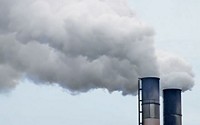Advertisement
Grab your lab coat. Let's get started
Welcome!
Welcome!
Create an account below to get 6 C&EN articles per month, receive newsletters and more - all free.
It seems this is your first time logging in online. Please enter the following information to continue.
As an ACS member you automatically get access to this site. All we need is few more details to create your reading experience.
Not you? Sign in with a different account.
Not you? Sign in with a different account.
ERROR 1
ERROR 1
ERROR 2
ERROR 2
ERROR 2
ERROR 2
ERROR 2
Password and Confirm password must match.
If you have an ACS member number, please enter it here so we can link this account to your membership. (optional)
ERROR 2
ACS values your privacy. By submitting your information, you are gaining access to C&EN and subscribing to our weekly newsletter. We use the information you provide to make your reading experience better, and we will never sell your data to third party members.
Environment
EPA Could Allow Toxic Emissions To Rise
Environmentalists, parts of agency decry plan that industry says would reward responsible actions
by Cheryl Hogue
April 24, 2006
| A version of this story appeared in
Volume 84, Issue 17
Earlier this month, industry groups and an environmental organization clashed over a plan from the Environmental Protection Agency. The Natural Resources Defense Council (NRDC) attacked EPA's plan as allowing chemical plants and refineries to boost emissions of carcinogens and other hazardous air pollutants. The American Chemistry Council (ACC) and the National Petrochemical & Refiners Association parried the attack, praising the policy for encouraging companies to curb their emissions of air toxics through control systems, pollution prevention, or both. Meanwhile, a leaked EPA memo shows that some agency higher-ups strongly oppose the policy.
While this may seem like business as usual in the milieu of Washington politics, there is a key difference—EPA hasn't even unveiled the policy yet. Only a draft version of the plan, distributed by NRDC, is available.
The brouhaha centers on a complicated part of the Clean Air Act that regulates 188 chemicals categorized as hazardous air pollutants, also known as air toxics. They range from acetaldehyde and benzene to vinyl chloride and xylenes. They also include a number of metals, including compounds of arsenic, chromium, lead, and mercury.
Industrial plants that emit these hazardous air pollutants get one of two designations under the Clean Air Act. One, termed a major source, applies to facilities that potentially can release more than 10 tons per year of any one listed compound, or 25 tons per year of any combination of these chemicals. Facilities emitting air toxics below these limits are classified as "area sources."
Major sources of air toxics face the heaviest regulation. By law, they must install what EPA calls maximum achievable control technology to reduce emissions. They also must report often to regulators about their emissions, keep records, and conduct monitoring. In contrast, area sources are less stringently regulated.
Under a 1995 EPA internal policy instituted by the Clinton Administration, once a factory is deemed a major source, the agency will always consider it a major source of air toxics. This holds even if a facility cuts its emissions to levels below the thresholds for the major source designation.
The disputed EPA plan would overturn this policy. Under the draft proposal, a major source could become a less regulated area source if the facility limits its potential to emit air toxics below the 10-ton-per-year and 25-ton-per-year thresholds.
Industry has been seeking this alteration for years, saying it would provide an incentive for plants to curb their emissions of hazardous air pollutants.
T. Ted Cromwell, ACC's senior director of regulatory affairs, says some chemical manufacturers have ratcheted down their emissions of air toxics as part of the industry's Responsible Care program. The draft regulatory change that would recognize and reward such environmentally positive actions "has been a long time coming," he says.
"This is encouraging companies to use more creative ways to get their emissions down and keep them down," Cromwell says.
Robert Slaughter, president of the National Petrochemical & Refiners Association, says, "A policy change along these lines is good news for protection of health and the environment." Major sources of air toxics, he explains, "would have to make actual emissions reductions through pollution prevention, installation of emission control systems, or a combination of both in order to take advantage of the policy."
Cromwell points out that many big facilities would be unable to take advantage of the planned regulatory changes. Because of the enormous size of their operations, these major sources are not likely to be able to ratchet their emissions of air toxics down to below the thresholds for an area source. But for other facilities, the draft policy is "an incentive to do better," he agrees.
What would happen after a major source is reclassified as an area source is the root of the plan's controversy. NRDC and regulators at eight of EPA's 10 regional offices scattered through the U.S. fear that the change would create a regulatory loophole and result in an increase in air toxics emissions.
"EPA would weaken the law and allow even more cancer-causing pollution into the air we breathe," says John Walke, clean air director for NRDC.
The rationale behind the 1995 policy, which is sometimes called "once in, always in," is that major sources that have installed the required maximum achievable control technology can end up reducing their emissions well below the 10-ton-per-year and 25-ton-per-year thresholds. If these facilities are reclassified as area sources, they could over time increase their releases of air toxics up to these limits with no regulatory repercussions, Walke says.
For instance, he says, imagine a refinery that emitted 100 tons per year of a combination of air toxics installing required technology that reduces its releases to 5 tons per year. As a major source, it must maintain its emissions at that level. Once it is reclassified as an area source, it could legally boost its releases to 25 tons per year.
EPA's draft proposal acknowledges that an increase in emissions of air toxics is a possible outcome of the policy change but downplays the possibility. "While this may occur in some circumstances, it is more likely that sources will adopt [emissions] limitations at or near their current levels to avoid negative publicity and to maintain their appearance as responsible businesses," it says.
Some staff members within EPA strongly disagree. The memo from eight of the agency's regional offices, dated December 2005, says this statement in the draft proposal "is unfounded and overly optimistic." The regions say their experience shows that facilities qualifying as area sources frequently are permitted pollution limits of 9 tons per year for any single air toxic or 24 tons per year for a combination of these chemicals.
Thus, the draft proposal "would be detrimental to the environment and undermine the intent" of the regulatory program to control air toxics from major sources, the regional offices say.
ACC's Cromwell says these fears are unfounded. Companies that get downgraded to the area source category would be unlikely to turn off their already-installed emission control technology, he says.
Plus, even with the proposed change, state, local, and federal regulators who issue pollution permits to factories could require a facility to maintain air toxic emission limits below the thresholds of 10 tons and 25 tons per year, he says.
Besides, Cromwell says, these thresholds apply to "every other area source out there" and thus should apply to facilities that would get downgraded from the major source category. The Clean Air Act considers these limits as acceptable levels for releases of air toxics from a facility, he says.
Walke disagrees, saying Cromwell's view doesn't square with the Clean Air Act. Nothing in that statute suggests that Congress set the 10- and 25-ton-per-year limits as a "floor" for regulation of hazardous air pollutants, Walke says.
There is also no good reason to allow plants that have curbed their emissions of air toxics for years to be allowed to "spew more cancer-causing chemicals into the air," Walke says. "There really is no public policy defense" for the planned change, he says.
Officials at EPA headquarters are keeping mum about the possible policy change, saying they can't comment because the plan is undergoing revision and hasn't been publicly released yet. EPA is expected to propose it formally later this year. Whatever thrust the agency takes on this issue, the battle lines have been drawn.





Join the conversation
Contact the reporter
Submit a Letter to the Editor for publication
Engage with us on Twitter